History of Elista
Foundation of Elista
In 1845, the Russian emperor Nicholas I issued a decree on afforestation of the Kalmyk steppe. In 1853, the first tree plantings were made by the forest department in the south of Ergeni (a plateau separating the basins of Azov and Caspian seas) and in the arroyo of the Elista River.
To increase the area of forest plantations, labor was needed, so the forest department petitioned the Ministry of State Property to organize a settlement of the Elista Forest Plantation. In 1859-1861, the Kumo-Manicheskaya scientific expedition led by the scientist Kostenkov outlined 15 places for founding settlements along the Crimean road between Krestovskaya station and Astrakhan, including the place in the Elista arroyo.
Before the foundation of the first settlement, the Kalmyks, who roamed along the Manych River, had their camps in the Elista arroyo. They called this place Elstoy (sandy) because the entire left northern slope of the arroyo was loose sand. This name became the name of the village that arose here.
The founder of Elista was the former Russian serf peasant Stepan Kiykov, who, on the advice of a Kalmyk named Bola, built the first dugout here in the spring of 1862. By the autumn of 1865, there were 15 families living in the village. This year is considered the foundation year of Elista. This village became widely known for the largest livestock fairs in the Kalmyk steppe.
More Historical Facts…
Elista in the first half of the 20th century
Administratively, the village belonged to Astrakhan Governorate. Subsequently, it became the center of Elista volost. In 1907, Elista became the center of Manych ulus of the Kalmyk steppe of Astrakhan Governorate. The ulus administration building, a school, and a hospital were built. In 1912, telegraph communication was established.
In February 1918, Soviet power was established here. On November 4, 1920, a decree was issued establishing Kalmyk Autonomous Oblast. The authorities of this region were temporarily located in Astrakhan. In 1925, the Fifth Congress of Kalmyk Soviets decided to transfer the center of Kalmyk Autonomous Oblast to Elista.
On March 10, 1930, the village of Elista was transformed into a town and merged with the town of the same name being under construction here. In 1935, Kalmyk Autonomous Oblast received an increase in its status and became the Kalmyk Autonomous Soviet Socialist Republic.
On August 12, 1942, during the Second World War, Elista was occupied by German troops. On September 9, 1942, about 600 Jews living in the town were shot. On December 31, 1942, Elista was liberated by the Red Army. Retreating German troops almost completely burned the town.
Deportation of the Kalmyks during the Second World War
On December 28-29, 1943, the Kalmyk people were deported to Siberia (Altai Krai, Krasnoyarsk Krai, Omsk Oblast, and Novosibirsk Oblast). The deportation of the Kalmyks was seen as a punishment for their alleged massive resistance to Soviet power and fight against the Red Army, as a means of resolving the national conflict that arose with the Kalmyks.
The main stage of the operation was carried out on December 28-29, 1943. A total of 46 echelons were formed to transport 93,139 people (26,359 families). Since the deportation took place in winter, the death rate during transportation was high. In 1944, the deportation continued, but to a lesser extent since most of the Kalmyks had already been displaced.
In 1947, 91,919 the Kalmyks were registered, the number of dead and deceased (including those who died from old age and other natural causes) from the beginning of the deportation amounted to 16,017 people.
On March 17, 1956, the Kalmyks were rehabilitated, they were allowed to return to their homeland. On November 14, 1989, the Supreme Soviet of the USSR recognized the deportation of the Kalmyks and other repressed peoples of the USSR as a “barbaric act of the Stalinist regime” and a serious crime. Subsequently, a series of laws on damages to the Kalmyks in connection with the deportation of 1943-1944 were adopted.
The law of the Russian Soviet Federative Socialist Republic of April 26, 1991 “On the rehabilitation of repressed peoples” recognized the repression of the peoples of the USSR as an act of genocide. Since 2004, December 28 is a memorial day for the victims of the deportation of the Kalmyk people. This day in Kalmykia is a day off.
Elista after the Second World War
In the period from 1943 to 1957, the Kalmyk Autonomous Soviet Socialist Republic was abolished. On May 25, 1944, Elista was renamed Stepnoy and became the center of the Stepnovsky district of Astrakhan Oblast, and since 1952 - Stavropol Krai. After the liquidation of the Kalmyk autonomy and the deportation of the Kalmyks, the city was not rebuilt and was in ruins.
Active restoration of the city began only in 1957, after the rehabilitation of the Kalmyks and the decision to restore the Kalmyk ASSR. The historical name was returned to the city. In 1969, a railway station was opened. Plants of reinforced concrete structures, a plant of large-panel housing construction and silicate brick, and an expanded clay plant began to operate.
In 1970-1980, housing construction continued, new cultural and educational institutions were opened. In these years, the Elista - Astrakhan and Elista - Volgograd roads were paved.
Elista - the capital of the Republic of Kalmykia
On February 20, 1992, the Supreme Council of the Kalmyk SSR adopted a resolution on renaming it to the Republic of Kalmykia.
In 1990-2000, a large number of monuments and buildings that reflect the cultural tradition of the Kalmyk people were built in Elista. In 1991, the Dalai Lama XIV visited Elista. The second visit of the head of the Buddhists of the world took place in 1992. This city has become one of the Buddhist centers of Russia.
In 1998, the 33rd World Chess Olympiad was held in Elista. For the Olympics, a large complex devoted to chess and chess competitions (Chess City) was built. Today, it hosts republican, national, and international chess competitions, as well as business and cultural meetings.
On Lenin Square - the central square of Elista
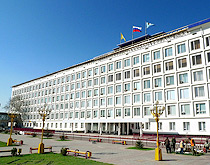
Government House of the Republic of Kalmykia in Elista
Author: Coolikova
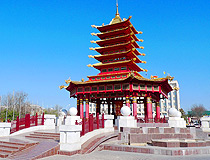
The Pagoda of Seven Days in Elista
Author: Coolikova
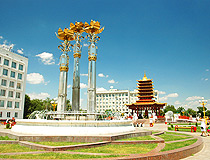
The fountain Three Lotus in Elista
Author: Kochergin Valery
Elista - Features
Elista is a city that is significantly different from many other settlements in Russia. It is located in the middle of the boundless Kalmyk steppes in the south-west of the Republic of Kalmykia, in the upper part of the valley of the Elista River. The City Day of Elista is celebrated on the 3rd Saturday of September.
The climate is temperate, sharply continental and is characterized by low rainfall, dry air, and high temperatures. Elista, after Astrakhan, is the second most arid administrative center of Russia. Winters are short, with little snow. The average temperature in January is minus 4 degrees Celsius, in July - plus 24.9 degrees ?elsius.
The coat of arms of today’s Elista was adopted in 2004. It consists of three colored fields. The red field is a symbolic gate made in oriental style, against the background of which the name of the city “Elista” is written in Russian. A white hadak descending from the gate is a symbol of benevolence in Buddhism and has the inscription “Elista” made in Kalmyk. On the green field, three snow-white nomadic tents are depicted. On the blue field, you can see a red disk of the sun.
According to the 2010 All-Russian Population Census, the ethnic composition is the following: Kalmyks (65.8%), Russians (25%), Kazakhs (0.6%). Representatives of almost all major world religions live in Elista. The largest number of believers are Buddhists and Orthodox.
Public transport in this city is represented only by minibuses. The federal highways R216 Stavropol - Elista - Astrakhan and R22 Elista - Volgograd pass through Elista. The airport of Elista offers regular flights to Moscow and St. Petersburg.
Elista is an important historical and cultural center of Kalmykia. The city has the theater of young spectators “Dzhangar”, the Republican Russian Drama and Comedy Theater, Kalmyk State Theater named after B. Basangov, as well as the State Concert Hall of the Republic of Kalmykia. The Republican Library named after A.M. Amur-Sanan, the largest library in Kalmykia, is located in Elista.
On the streets of the city you can see sculptural compositions related to the history, mythology, culture, and religion of the Kalmyk people. A lot of them were installed as a result of international competitions with the participation of sculptors from Japan, Bulgaria, Lithuania, Armenia, Georgia, and Russian cities.
In mid-September, Elista hosts the republican national cultural and sports festival “Dzhangariada” dedicated to traditional Kalmyk sports (archery, javelin and lasso throwing, national wrestling, horse racing for 45 km, horseback riding).
Main Attractions of Elista
The Golden Abode of the Buddha Shakyamuni (the Burkhan Bakshin Altan Sume) - the largest Buddhist temple in the Republic of Kalmykia and one of the largest Buddhist temples in Europe. This temple built in 2005 is among the main attractions of Elista.
In this 56 meters high building, you can see the largest Buddha statue in Russia and Europe (9 m). Prayers, celebratory divine services, and rituals are performed here. On the ground floor there is a museum of the history of Buddhist culture. Yuriya Klykova Street.
Lenin Square - the central square of Elista. The picturesque rotunda “The Pagoda of Seven Days”, the fountain “Three Lotus”, and a monument to Lenin can be found here. In the very center of the square there is a chess board made of black and light granite (5x5 meters) on which you can play a game of chess.
Friendship (Druzhba) Park - a popular holiday destination for residents of Elista located along Lenina Street. There are a lot of monuments, cultural objects, and memorial complexes here. In the immediate vicinity of the park there is another attraction - the Golden Gate of Elista.
The Golden Gate of Elista is a unique exotic monument of Buddhist architecture, the most recognizable sight of Elista installed in the 1990s. The monument illustrates the whole history of Kalmyks. This 15-meter golden arch supported by red columns is located at the intersection of Lenina and Nomto Ochirova streets.
“City-Chess” - an unusual urban area built specifically for the 33rd World Chess Olympiad on the southeastern outskirts of Elista in 1998. The main building of the complex is the Chess Palace, which hosts championships and tournaments. The Chess Museum is also located here. There are a lot of different sculptures created by people from all over the world here. Ostapa Bendera Avenue.
The National Museum of the Republic of Kalmykia named after N.N. Palmov - the only museum where the history, culture, and art of the Kalmyk people are most fully represented. Today, the museum has 7 stationary exhibitions devoted to the history, ethnography, culture of the Kalmyk people, objects of the Buddhist cult, Old Kalmyk art, as well as contemporary fine art of Kalmykia. Dzhangara Street, 9.
The Museum of Fine Arts of the Republic of Kalmykia. This museum exhibits paintings created by Kalmyk artists, as well as thangkas (Tibetan Buddhist paintings) and sculptures of the deities of the North Buddhist pantheon. Here you can also see some works of masters of Western European and Russian art. In addition, this museum has engravings of the 18th - early 20th centuries made by Chinese and Japanese artists, as well as objects of applied art from Southeast and Central Asia. Microdistrict #1, building #32.
The Golden Horseman - an 8-meter-high monument rising on a high stele on an artificial hill at the entrance to Elista from Volgograd. The image of a man on a horse looking into the distance - the hero of the folkloric epos “Dzhangar” - symbolizes the courage, daring, and valor of the Kalmyks. This gilded monument is located at the intersection of Budennogo and Dzhangara streets.
Exodus and Return - a memorial complex devoted to the victims of Stalinist repressions located on the eastern outskirts of Elista. On December 29, 1996, a monument was installed on an artificial mound in memory of the deportation of the Kalmyk people to Siberia in 1943-1944. It was cast in bronze in New York, USA. Annually, on December 28 (the Day of Remembrance of the Victims of the Deportation of the Kalmyk People), commemoration of the victims of this tragic event takes place near this monument. Khrushcheva Street.


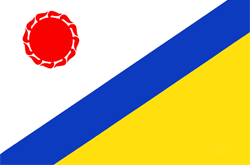
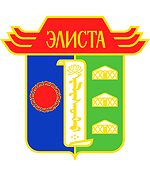
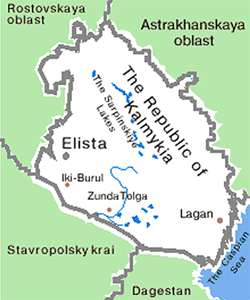



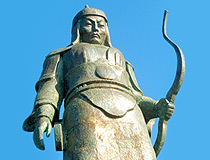
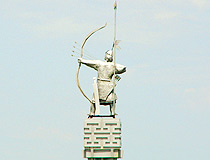
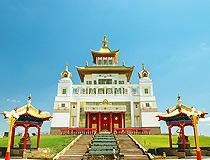
The comments of our visitors